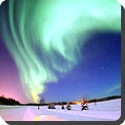 An aurora is a natural light display in the sky, particularly in the polar regions, caused by the collision of charged particles directed by the Earth’s magnetic field. An aurora is usually observed at night and typically occurs in the ionosphere. It is also referred to as a polar aurora or, collectively, as polar lights. These phenomena are commonly visible between 60 and 72 degrees north and south latitudes, which place them in a ring just within the Arctic and Antarctic polar circles. Auroras do occur deeper inside the polar regions, but these are infrequent and often invisible to the naked eye.
An aurora is a natural light display in the sky, particularly in the polar regions, caused by the collision of charged particles directed by the Earth’s magnetic field. An aurora is usually observed at night and typically occurs in the ionosphere. It is also referred to as a polar aurora or, collectively, as polar lights. These phenomena are commonly visible between 60 and 72 degrees north and south latitudes, which place them in a ring just within the Arctic and Antarctic polar circles. Auroras do occur deeper inside the polar regions, but these are infrequent and often invisible to the naked eye.
In northern latitudes, the effect is known as the aurora borealis (or the northern lights), named after the Roman goddess of dawn, Aurora, and the Greek name for the north wind, Boreas, by Pierre Gassendi in 1621. Auroras seen near the magnetic pole may be high overhead, but from farther away, they illuminate the northern horizon as a greenish glow or sometimes a faint red, as if the Sun were rising from an unusual direction. The aurora borealis most often occurs near the equinoxes. The northern lights have had a number of names throughout history. The Cree call this phenomenon the “Dance of the Spirits”. In Europe, in the Middle Ages, the auroras were commonly believed a sign from God.
 Kids Portal For Parents India Kids Network
Kids Portal For Parents India Kids Network






